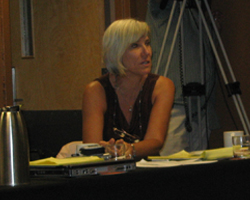Microbial Risk Assessment, Education, and Knowledge Management
- Joan Rose, Ph.D.
- Professor
- Department of Fisheries and Wildlife
- Homer Nowlin Chair in Water Research
- College of Agriculture and Natural Science
What is the risk of disease spreading in our communities, in our schools, to our children? What biological agents represent the greatest risk associated with contaminated indoor environments, our water or our food? How clean is safe?*These are some of the questions that the Center for Advancing Microbial Risk Assessment (CAMRA), housed at Michigan State University, addresses as it creates research knowledge and strategies to promote public health security in the United States.

Dr. Joan B. Rose is an internationally known water microbiologist in MSU's Department of Fisheries and Wildlife, with a joint appointment in Crop and Soil Sciences. She also holds the Homer Nowlin Chair in Water Research. Dr. Rose and Dr. Charles N. Haas, of Drexel University's Department of Civil, Architectural & Environmental Engineering, established CAMRA in 2005 on a five-year federal grant. Rose and Haas, who had collaborated on various projects in the past, now co-direct the Center. CAMRA is jointly funded by the Environmental Protection Agency and the Department of Homeland Security.
Merging Sciences to Understand Risk
CAMRA focuses on both the technical science and the knowledge management and exchange of quantitative microbial risk assessment (QMRA) data among various audiences such as scientists, policy makers, and first responders. Additional CAMRA investigators are affiliated with MSU, Drexel, Carnegie Mellon University, Northern Arizona University, University of Arizona, University of California at Berkeley, and the University of Michigan.
As Rose explains it, QMRA is the "merging of biology, environment, water, and mathematics to try to understand risk when we get exposed" to a pathogen or a microorganism in air and water as well as on various surfaces.
CAMRA's main areas of research are exposure assessment; infectious disease transmission; dose-response; risk characterization, communication, and integration of QMRA science; and knowledge management and education.
For the past four years, Rose and her CAMRA colleagues have operated a Summer Institute for approximately 120 participants from academe and professionals from government and private sector companies around the world. Dr. Rose calls the Institute a "crash course on undertaking a risk assessment." Participants are teamed up across disciplines and given real life case studies to work on.
Targeting Research, Containing Costs, Sharing Findings
Rose often works with communities and other organizations on problems such as beach cleanups and sewage spills. She believes that narrowing the research problem to "something reasonable" is the key to successful community engagement, and says that while communities and industries both want to have their critical questions answered in a timely manner, industries are particularly concerned with costs as well.
Dr. Rose also emphasizes the need to translate her own and her colleagues' research into practice, much the way science is translated for application in the medical world. "We need to do more of that in water and environmental science, climate change, all of those areas," says Rose. "It's going to be extremely important."
"You look for things that we think might be harmful in water [and] you can find them but you don't really have a yardstick to judge what this risk might be...is one virus, ten viruses per liter too many—what's the yardstick? How do you judge that?"
Joan Rose
Dr. Shannon Briggs, toxicologist with the Water Bureau at the Michigan Department of Natural Resources and Environment, says of Rose's contributions, "Dr. Rose is amazing. She's done a lot to improve water quality testing and is one of the world's experts in water research. She's connected to other world experts and enthusiastically brings new technologies to many groups, stakeholders and governments in the Great Lakes Region."
Creating a Yardstick to Assess Risk
With future funding yet to be determined, Rose wonders what the Center may evolve into. In the immediate future, CAMRA is, in addition to continuing its research, creating a wiki so that its audiences—at the moment, scientists—can put forward the models, data, and frameworks that have resulted from their work with CAMRA. As Rose explains it, "We want a wiki format because QMRA is bigger than CAMRA people and what we like to do is engage the... [larger] community of people [who] are involved in the science of QMRA." The information is also being stored in a "data warehouse" as part of CAMRA's knowledge management and QMRA education project.
CAMRA will start with adding to the wiki the "dose response functions" that its investigators have developed, which now number up to 40, for different organisms. These dose response functions provide the yardstick, so that, as Rose notes, if one gets "exposed to this organism at these concentrations this is the probability of infection." Related questions being addressed include: "How do we get exposed and to what concentration over what time? How do we match that with the probability of infection to do prediction and to [create and implement] management strategies?" As Rose states, "Our core is going to be these dose response functions."
Dr. Rose has had numerous honors and awards over the years. Recently, in recognition of her work, she was named an AAAS Fellow by the American Association for the Advancement of Science.
- Written by Catherine Gibson, University Outreach and Engagement
- Photograph courtesy of Joan Rose
*Rose, J. B., Haas, C. N., & Weir, M. H. (2009, 30 November). Center for Advancing Microbial Risk Assessment Year-4 Annual Report (pp. 3, 6). East Lansing, MI; Philadelphia, PA: Michigan State University Department of Fisheries and Wildlife; Drexel University Department of Civil, Architectural & Environmental Engineering.